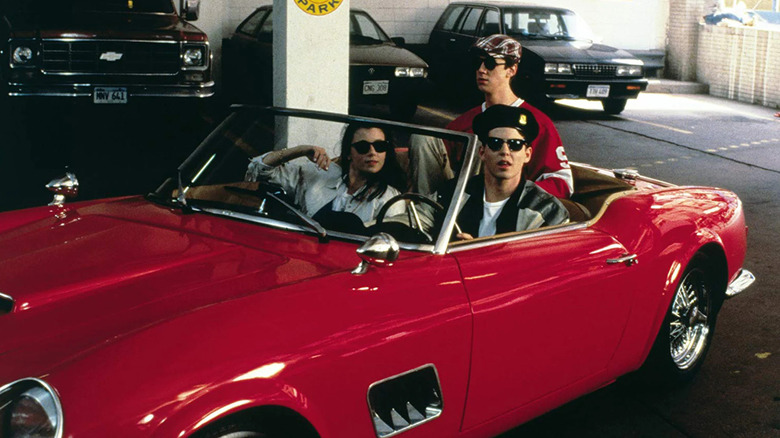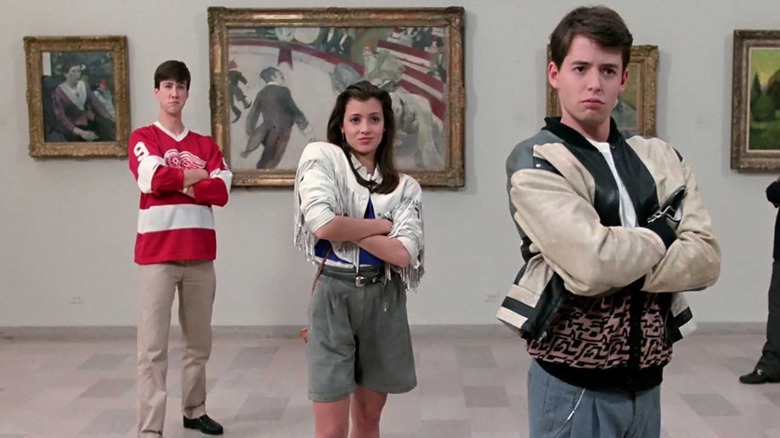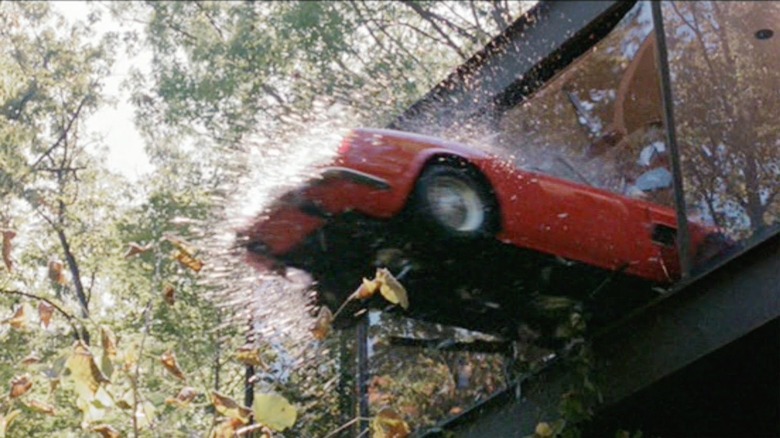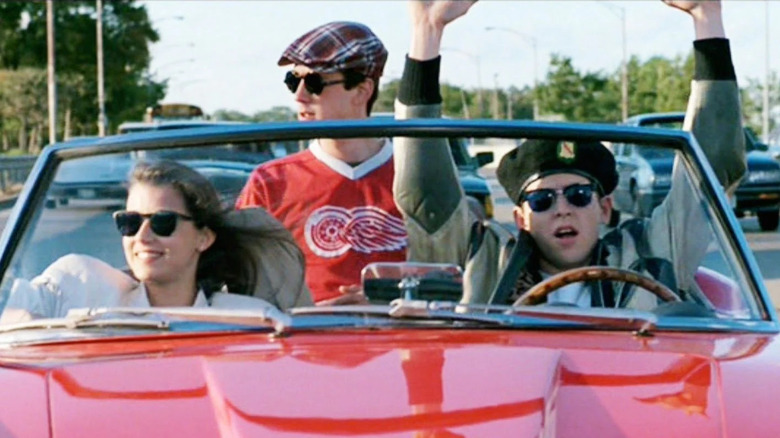Ferris Bueller's Day Off's Signature Ferrari Wasn't As Real As You Might Think
I've never been much of a car person. I don't even know what brand our family runaround is; to me it's just a red thing with four wheels and some seats inside. I don't even have a driver's license, and I always start looking for an excuse to leave a conversation when other guys start talking about horse power and stuff like that. Yet despite my general lack of interest in all things automotive, there are a few movie cars that leave me salivating.
If I had my pick, I'd take a 1970 Dodge Challenger from "Vanishing Point." Of course, I wouldn't say no to James Bond's Aston Martin either, even if it was just to play around with the bullet-proof screen, missile launchers, and ejector seat. As for the gorgeous Plymouth Fury in "Christine," I'd take my chances with her murderous moods just to give her a spin around the block.
Then you have the Ferrari in "Ferris Bueller's Day Off," John Hughes' classic '80s comedy about a high school chancer and his mission to play hooky one more time before graduation. The movie's key prop is a pristine, astonishingly rare 1961 Ferrari 250 GT California Spyder, and from the moment it appears on screen we know it'll end up trashed. It is the comedy equivalent of Chekhov's gun, like the piano Stan and Ollie are lugging up the flight of stairs in "The Music Box." If you present a valuable, prized item in the first act, it must absolutely get destroyed by the time the credits roll. The tension arises from one question: how?
So what happens in Ferris Bueller's Day Off again?
Out in the suburbs of Chicago, it's not long before graduation for Ferris Bueller (Matthew Broderick), a wise-ass popular among all the "sportos, motorheads, geeks, sluts, bloods, wasteoids, dweebies, dickheads" at his school who think he's a "righteous dude." Despite having a few strikes against his name for truancy already, he decides to pull one last sickie and make it his masterpiece, concocting an elaborate ruse for his trusting parents and persuading his downbeat best friend, Cameron (Alan Ruck), to join him for the ride. What they need is a set of wheels, and Ferris browbeats Cameron into taking his dad's beloved red Ferrari out for the day.
The vintage motor is instrumental in busting Ferris's girlfriend Sloane (Mia Sara) out of class under the nose of dean Ed Rooney (Jeffrey Jones), Bueller's uptight nemesis who is hellbent on catching him. Next stop, downtown Chicago for a freewheeling excursion taking in art galleries, baseball games, and swanky restaurants, before a show-stopping lip sync performance from Ferris at a huge parade. With both Rooney and his jealous sister Jeannie (Jennifer Grey) on his tail, can Ferris pull off this monumental skive and make it back to his sick bed before his parents get home from work?
"Ferris Bueller's Day Off" came at the end of John Hughes's great run of influential '80s teen movies including "Sixteen Candles" and "The Breakfast Club," and it's one of the great comedies of the decade. It is an exuberant and good-hearted wish-fulfillment fantasy that plays as a youthful celebration of "seize the day." On the few occasions I skipped school, I just ended up sitting around watching videos all day, so Bueller's city-wide adventure was always a thing of envious wonder for me. He's a character that could have come across as smarmy and insufferable in other hands, but Broderick plays him with such irresistible brio that it's impossible not to root for his one last shout for mischievous rebellion.
What happens to the car?
From the moment we lay eyes on the Ferrari in "Ferris Bueller's Day Off," we know it'll probably end up totalled. Cameron is constantly worried about it and, from what we hear about his father, with good cause. We never meet the character, but he sounds like a rather stern and unloving dad, resulting in the anxiety-ridden and listless young Cameron we see at the start of the movie.
It's all set up when the Ferrari is first introduced to the strains of "Oh Yeah" by Yello ("Chicka Chicka!") when Cameron tells Ferris that his father never drives it and knows the exact mileage. We know he'll be in a world of s**t if there is the slightest scratch, played to comic effect when they leave the car with a shifty garage attendant (Richard Edson) who instantly takes it out joy-riding as soon as they turn their backs. Despite this, the car is returned to them in apparently pristine condition at the end of the day, but there is a major hitch: while the odometer only had a few miles on the clock to begin with, it now reads much higher.
Ferris's simple solution of running the car in reverse while propped up doesn't work at all. That's when Cameron's deep well of frustration boils to the surface, deciding he must take a stand against his father's domineering ways otherwise he will get pushed around for the rest of his life. He vents his anger by kicking the car, breaking the lights and denting the front fender and hood. He has no place to hide now, and a last contact knocks the car off its props and sends it careening through the plate glass window, into the wooded crevasse below.
"Ferris Bueller" is a relentlessly light-hearted film but has a sincere emotional core in Cameron, and this is his cathartic scene. We know Ferris and Sloane will be totally fine as they breeze through life, but we worry what will happen to Cameron if he stays in his father's shadow. He might be comfortable financially, but life will be a joyless slog as long as the old man has any hold over him. His father's miserly attitude is symbolized by the Ferrari: he has acquired the wealth to own such a beautiful vehicle, but he is so mean and cautious that he won't even drive the thing. With the car a smoking wreck, Cameron has no choice but to finally stand up to his dad, and it will be his first step towards becoming a stronger-willed individual.
Want to buy a Ferrari just like the one in the movie?
"It is so choice!" Ferris remarks about the Ferrari, and he's not kidding. This car is a 1961 Ferrari 250 GT California Spyder and only 56 were ever made. In 2016, one went up for public auction for the first time in over 50 years and sold for an incredible $17.16 million (via Auto Blog).
However, even at '80s prices and with the financial backing of Paramount, John Hughes couldn't afford to trash the real thing for the movie. The solution was using replicas for the driving scenes, and a genuine model was brought in for close-up shots. This was made possible when Hughes learned about a company called Modena Design and Development, who produced the Modena California Spyder, a replica of the incredibly rare vintage automobile. Hughes commissioned them to build three cars for use as the original's stunt double. Neil Glassmoyer of Modena explained (via Auto Blog):
"They gave us 4 weeks to build the movie cars... I always say we built two and a half cars; two were interchangeably used as a Hero and stunt cars and one was a rolling fiberglass shell that was used in the destruction scene. This car was actually intended for the stunk work, but both saw action, and both wound up with broken front suspension bolts because the big jump scene took nine takes between the two cars."
The replicas used in the film also sell well at auction. In 2020, "Chassis 001," a fully refurbished by Modena, sold for almost $400,000 (via Motor Trend). That's peanuts compared to the real thing and a classy piece of drivable movie memorabilia to impress your film buff friends. If you can't afford an original or persuade the owners of the three "Ferris Bueller" stand-ins to part with theirs, GTO Engineering last year announced the launch of the California Spyder Revival (via Car Buzz). Handcrafted and taking around 1,500 hours to put each unit together, one will cost you around $1 million. But as Ferris might say, "If you have the means I highly recommend picking one up."



